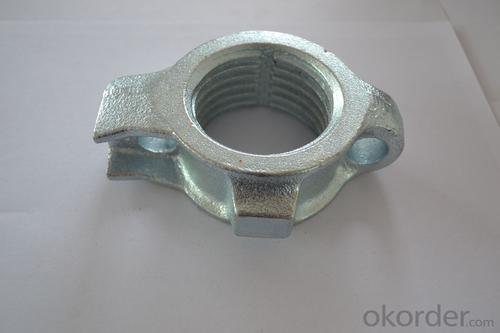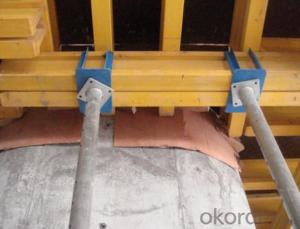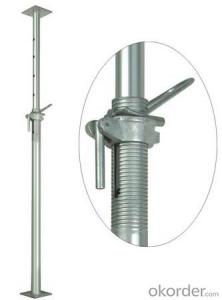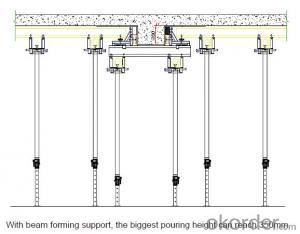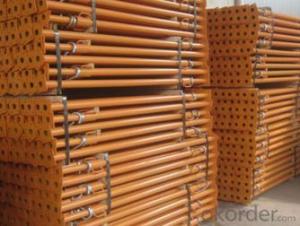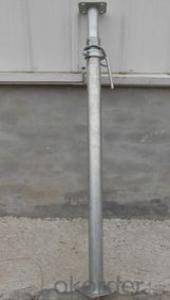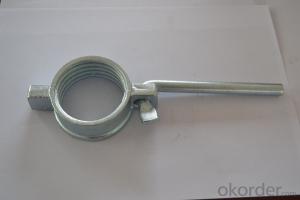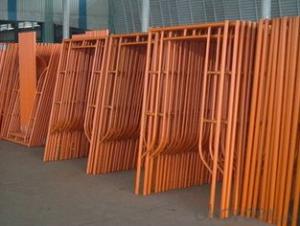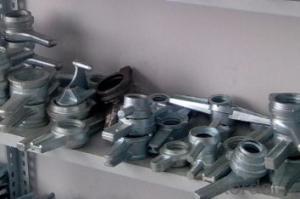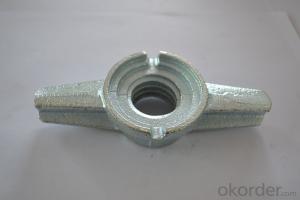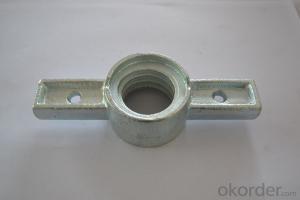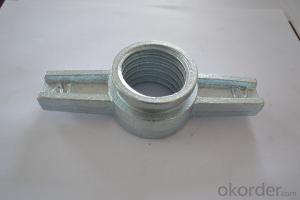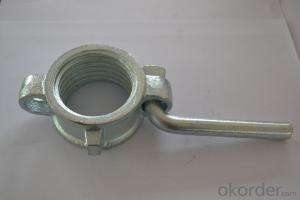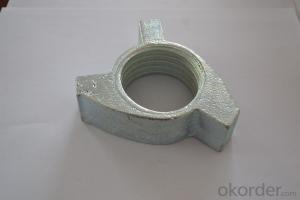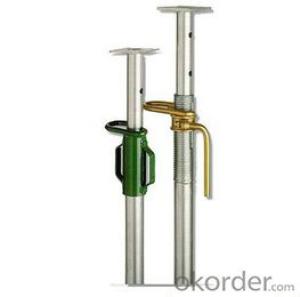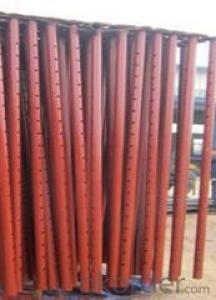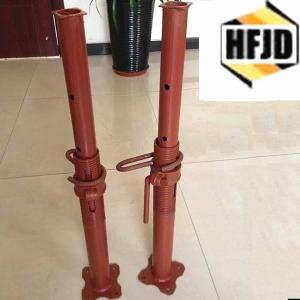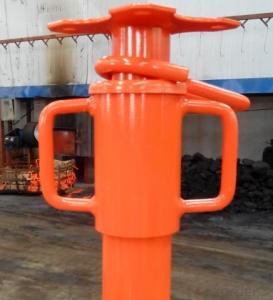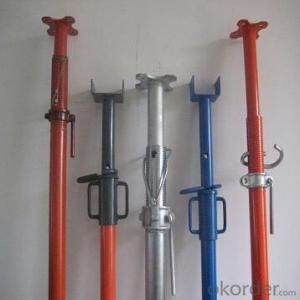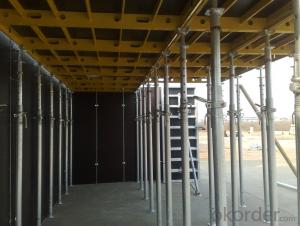OEM Two wing Butterfly Wing Nuts 2
- Loading Port:
- China Main Port
- Payment Terms:
- TT OR LC
- Min Order Qty:
- -
- Supply Capability:
- -
OKorder Service Pledge
OKorder Financial Service
You Might Also Like
Quick Details
| Model Number: | |||||
| Standard: | Type: | Certification: | |||
| Material: | Surface: |
Packaging & Delivery
| Packaging Detail: | Plastic bag, pallet packing, carton box, by customer's requirement |
| Delivery Detail: | within 30days after payment |
Specifications
Two wing Butterfly Wing Nuts
1>Excellent dimension accuracy
2>Finished: per your requirements
3>factory directly supply
Two wing Butterfly Wing Nuts
We supply kinds of metal parts totally according to clients' drawings and samples and special requirement.
1. Material: Ductile iron .
2. Sizes: Inner hole Dia 15/17mm.
We have different sizes ,types of wing nut to meet your needs, save your cost .
3. Weight: 0.35kg,thread pitch: 10.0mm.(or 6.35mm)
4. Surface: White Zinic , Yellow Zinic or painted, self color
5 Thread:casted or machine tap.
1. 12000M2 standard modern workshop guarantee production capability to satisfy the customers needs
2. Our Independent quality control department,Which make sure the quality of all products
3. Our efficient and experienced sales team ,provide friendly and thoughtful service for clients from all over the world
- Q: Subway construction steel support axial force design value of KN/m, the construction to be converted into MPa, how to calculate?
- If:The design of prestress value is 300KNJack cross-sectional area of 0.017671 square metersApply prestress = Design prestress value / Jack cross-sectional area =300/0.017671/1000=1.70MPa
- Q: Can steel props be used in tunnel construction?
- Indeed, tunnel construction can make effective use of steel props. These props are extensively employed in a diverse range of construction endeavors, including tunnel construction, to furnish provisional reinforcement to excavated regions. Their adjustability allows for easy installation, and they offer steadfast support to the tunnel walls and roof throughout construction. Manufactured to endure tremendous loads, these props guarantee the stability and security of the tunnel structure. The benefits of steel props are manifold, encompassing remarkable load-bearing capacity, effortless installation, and adaptability in adjusting both height and length. Consequently, they represent a fitting selection for tunnel construction ventures necessitating temporary support.
- Q: What are the safety guidelines for working with steel props?
- To ensure the well-being of workers and prevent accidents when working with steel props, it is important to adhere to several safety guidelines. Consider the following key safety guidelines: 1. Thoroughly inspect steel props before use to identify any signs of damage or defects. This includes checking for cracks, bends, or other structural issues that may compromise their stability. 2. Use proper lifting techniques to handle the heavy and cumbersome steel props. Avoid excessive bending, twisting, or overreaching to prevent strains or sprains. 3. Position steel props on a stable and level surface to prevent tipping or collapsing. Clear any loose debris or obstacles from the area and ensure the ground is firm. 4. Be aware of the load capacity of each steel prop and do not exceed it. Determine the weight of the load being supported and select a prop with a sufficient load-bearing capacity to avoid failure and potential accidents. 5. Ensure secure connections between different sections of the steel prop, as loose connections can compromise its stability and increase the risk of collapse. 6. Place steel props at regular intervals to provide adequate support. The spacing between props will depend on the load and type of work being carried out. Follow the manufacturer's guidelines or consult with a structural engineer if unsure. 7. Position steel props to avoid obstructions or potential hazards, such as electrical cables, pipes, or other equipment. This reduces the risk of accidental damage or injury. 8. Regularly inspect and maintain steel props to ensure their functionality and safety. Check for rust, lubricate moving parts, and replace any damaged or worn-out components. 9. Provide proper training and supervision to workers to ensure the safe use of steel props. This will help ensure that all safety guidelines are followed correctly and minimize the risk of accidents. 10. Wear appropriate personal protective equipment, such as hard hats, safety boots, gloves, and high-visibility clothing, when working with steel props. This protects workers from potential hazards and ensures their overall safety on the job. By adhering to these safety guidelines, workers can minimize the risk of accidents and establish a safe working environment when using steel props. Prioritize safety and take necessary precautions to protect both workers and the surrounding area.
- Q: What are the different materials used for steel props?
- Steel props, also referred to as adjustable steel props or steel scaffolding props, play a vital role in construction by providing support to temporary structures like walls, beams, and slabs. To ensure strength, stability, and durability, these props are manufactured using different materials. 1. Steel: The primary material used in the production of steel props is steel itself. Steel is renowned for its high tensile strength, enabling it to withstand heavy loads. To ensure the necessary resistance against compression and bending forces, steel props are typically crafted from high-quality steel. 2. Galvanized Steel: Another variant of steel props involves a coating of zinc through the process of galvanization. This protective layer enhances the props' resistance to corrosion and prolongs their lifespan. By preventing rust and deterioration, galvanized steel props are suitable for both indoor and outdoor construction projects. 3. Aluminum: While less prevalent than steel, aluminum is also utilized in the fabrication of steel props. Aluminum props possess the advantage of being lightweight and easy to handle, making them ideal for situations that require portability. They are often employed in smaller-scale construction projects or areas with weight restrictions. 4. Composite Materials: In recent years, the construction industry has witnessed a rise in the popularity of composite materials. These materials are typically produced by combining plastic or fiberglass with other components. They offer excellent strength-to-weight ratios and resistance to corrosion. Composite steel props are lightweight, durable, and resistant to weathering, making them suitable for various construction purposes. The selection of material for steel props relies on factors such as load-bearing requirements, environmental conditions, and budget limitations. Steel props made from high-quality steel or galvanized steel are widely utilized due to their exceptional strength and durability. Aluminum props are favored when weight is a significant consideration. Additionally, composite materials are gaining prominence as a viable alternative to traditional steel props, as they offer a combination of strength, lightweight properties, and resistance to corrosion.
- Q: How do steel props contribute to the overall efficiency of construction projects?
- Steel props contribute to the overall efficiency of construction projects by providing temporary support to structures, ensuring safety and stability during construction. They are adjustable in height and can be easily installed and removed, allowing for quick and precise positioning. This versatility enables contractors to efficiently manage different construction stages, reducing labor and material costs. Additionally, steel props offer high load-bearing capacity, which increases construction productivity by allowing for larger spans and reducing the need for additional supports.
- Q: Can steel props be used for temporary support in tunnel boring operations?
- Yes, steel props can indeed be used for temporary support in tunnel boring operations. Steel props, also known as steel struts or steel shores, are commonly used in construction and civil engineering for temporary support in various applications, including tunneling operations. During tunnel boring operations, steel props can be installed to provide temporary support to the tunnel walls and roof until a permanent support system, such as shotcrete or segmental lining, is installed. These props help to prevent ground movement, collapse, or cave-ins, ensuring the safety of workers and equipment inside the tunnel. Steel props are typically adjustable in length, allowing for flexibility in supporting different tunnel sizes and shapes. They are designed to withstand high loads and can be easily installed and removed as the tunneling progresses. The props are usually placed at regular intervals along the tunnel, ensuring even distribution of support throughout the excavation. In addition to their strength and adjustability, steel props offer other advantages for tunnel boring operations. They are durable, resistant to corrosion, and can be reused in multiple projects, making them a cost-effective solution. Furthermore, their installation and removal require minimal equipment and manpower, reducing the overall time and effort required for tunnel construction. However, it's important to note that the use of steel props for temporary support in tunnel boring operations should be done under the guidance and supervision of experienced engineers. Proper design, installation, and monitoring are crucial to ensure the stability and safety of the tunnel during construction.
- Q: What are the main advantages of using heavy-duty steel props?
- There are several main advantages of using heavy-duty steel props. Firstly, heavy-duty steel props are known for their exceptional strength and durability. Being made of high-quality steel, these props can withstand heavy loads and provide reliable support for various construction projects. Their robust construction ensures that they can withstand the pressures and demands of construction sites, making them a reliable choice for contractors and builders. Secondly, heavy-duty steel props offer great versatility. Their adjustable design allows for easy height adjustment, making them suitable for a wide range of applications and projects. Whether it is supporting formwork, beams, or slabs, heavy-duty steel props can be extended or retracted to the required height, providing flexibility and adaptability on construction sites. Another advantage of using heavy-duty steel props is their stability and safety. The strong steel construction ensures that these props can securely hold and support the weight of the structure or material they are used for. This helps to prevent accidents and collapses, providing a safe working environment for construction workers. Furthermore, heavy-duty steel props are cost-effective. Due to their durability and long lifespan, these props can be used repeatedly for multiple projects, reducing the need for frequent replacements or repairs. This helps to save costs in the long run and makes them a cost-effective choice for construction companies. Lastly, heavy-duty steel props are easy to use and assemble. Their simple design allows for quick and hassle-free installation, saving time and effort on construction sites. Additionally, their adjustable height feature allows for easy customization to meet specific project requirements. In conclusion, the main advantages of using heavy-duty steel props include their strength, versatility, stability, cost-effectiveness, and ease of use. These props provide reliable support for construction projects, ensuring safety and efficiency on the job site.
- Q: Are steel props suitable for use in tunnel construction?
- Yes, steel props are suitable for use in tunnel construction. Steel props are commonly used in construction projects, including tunnel construction, due to their strength and durability. They provide support and stability to the tunnel walls and roof, ensuring the safety of workers and the success of the project. Steel props are known for their load-bearing capacity and can withstand heavy loads, making them ideal for use in tunnels where there is a significant amount of earth and rock pressure. Additionally, steel props are adjustable, allowing for easy installation and flexibility in accommodating different tunnel sizes and shapes. Overall, steel props are a reliable and practical choice for tunnel construction, providing the necessary support and stability required for the project.
- Q: How do you prevent accidents or injuries while using steel props?
- In order to prevent accidents or injuries when using steel props, it is important to adhere to several important measures: 1. Training and knowledge: Prior to handling steel props, it is crucial to receive proper training in their use. Take the time to familiarize yourself with the manufacturer's instructions, safety guidelines, and any specific precautions that must be taken. 2. Regular inspections: Before utilizing steel props, thoroughly inspect them for any indications of damage, such as cracks, bends, or excessive wear. If any issues are discovered, promptly repair or replace them to guarantee their effectiveness and safety. 3. Proper handling and storage: When handling steel props, make sure to utilize appropriate lifting techniques and avoid overloading them beyond their designated capacity. Additionally, store them securely in a safe location to prevent accidental damage or knocking them over. 4. Secure placement: To prevent shifting or collapse during use, ensure that steel props are positioned and anchored properly. Follow the manufacturer's guidelines for correct placement and confirm that the supporting surface is stable and capable of bearing the load. 5. Clear communication and coordination: If multiple workers are involved in the use of steel props, clear communication and coordination are vital. Establish a system of signals or verbal communication to ensure that everyone is aware of the activities being performed and can take necessary precautions. 6. Personal protective equipment (PPE): Always wear the appropriate personal protective equipment, such as safety gloves, goggles, and steel-toed boots, when handling steel props. This will provide protection against potential accidents or injuries resulting from sharp edges, falling debris, or other hazards. 7. Regular maintenance: Regularly maintain steel props by cleaning, lubricating, and inspecting them to ensure optimal performance and longevity. Promptly replace any damaged or worn-out parts. 8. Risk assessment: Before using steel props, conduct a thorough risk assessment to identify potential hazards and implement suitable control measures. Consider factors such as the load being supported, environmental conditions, and the presence of other workers or equipment nearby. By adhering to these preventive measures, individuals can significantly minimize the risk of accidents or injuries when using steel props, resulting in a safer working environment for everyone involved.
- Q: How do steel props compare to screw jacks in terms of stability?
- Steel props are generally considered to be more stable than screw jacks. This is because steel props provide a more solid and rigid support due to their sturdy construction and design. Screw jacks, on the other hand, are adjustable and rely on a threaded mechanism, which may introduce some potential instability. However, it's important to note that the stability of both steel props and screw jacks can be influenced by factors such as the load they are supporting and the conditions of the surrounding environment.
Send your message to us
OEM Two wing Butterfly Wing Nuts 2
- Loading Port:
- China Main Port
- Payment Terms:
- TT OR LC
- Min Order Qty:
- -
- Supply Capability:
- -
OKorder Service Pledge
OKorder Financial Service
Similar products
Hot products
Hot Searches
Related keywords

